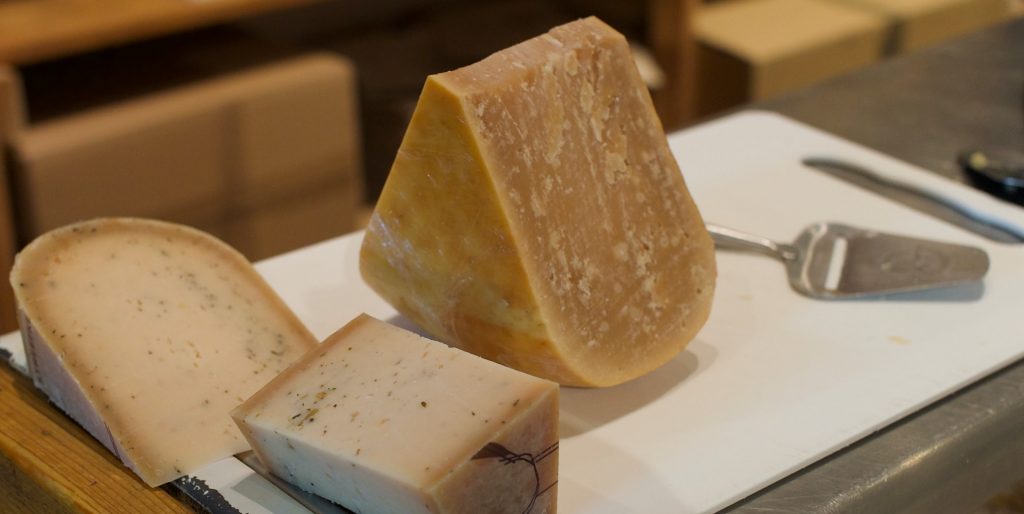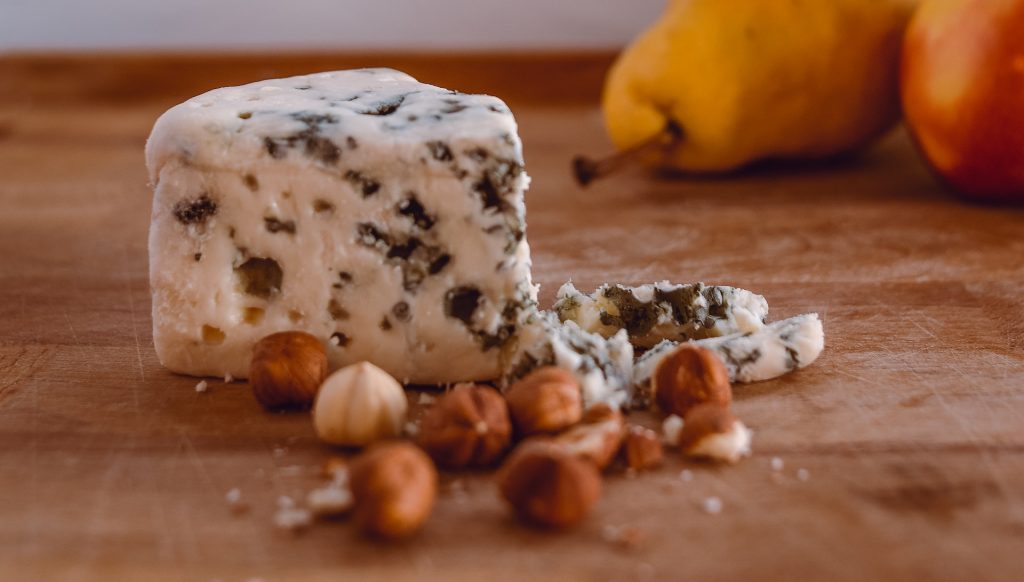If you’ve recently come back from a supermarket shop, or if you’ve just enjoyed one of our delicious grazing tables and want to store the leftovers, then you should know how to do so properly. In this article, we discuss how to professionally wrap and store your cheese to preserve freshness and make your cheese last longer. But most importantly, how should you store cheese?
You should avoid storing your cheese in an airtight container, as this can contribute to moisture and flavour loss. Instead, wrap your cheese in specialist cheese or wax paper, and place into the bottom draw of your fridge. Feta, burrata, and mozzarella should be submerged in water or olive oil before being placed in the fridge.
Read on to find out more about wrapping your cheese, storing specific cheese types, and freezing your cheese.
Cheese Storage Basics
We explore four key areas of cheese storage; temperature, humidity, air flow, and time. Find out more below:
Temperature
Soft cheese (like cottage cheese, feta, or goat’s cheese) needs to be kept refrigerated to remain safe for consumption. Ideally, your fridge will be between 5 and 8°C. Hard cheese (such as gouda, cheddar or parmesan) do not require refrigeration, however they won’t last as long at room temperature.
Humidity
In order to retain moisture and help the aging process, cheese should ideally be stored in a humid environment, with humidity levels around 75%-95%. However, if you’ve purchased pre-wrapped cheese from your local farm shop or supermarket, you don’t need to worry about humidity when storing your cheese.
Air Circulation
For the aging process to be effective, cheese should be kept in a room with good air circulation. This allows the cheese to ‘breathe’. If the air circulation is poor, you may have a negative impact on the cheese’s flavour. Alternatively, if the air circulation is too high, you may find cracks in your cheese.
Storage Duration
Different cheeses have varying storage lifespans. Soft cheeses generally need to be consumed within a shorter time frame, while harder cheeses can last longer. Refer to the storage duration recommendations on cheese packaging for each cheese type.
How you handle your cheese may also change depending on the type. If you’d like to find out more about the popular brie and camembert, read our recent blog.

What is the Best Way To Wrap Cheese?
Wrapping cheese properly is essential to preserve its freshness, flavor, and texture. The right wrapping technique can help maintain the optimal moisture balance, prevent the growth of mold, and protect the cheese from absorbing unwanted odors. Here’s a step-by-step guide on how to wrap cheese effectively:
1. Choose Your Wrapping Material
- Cheese Paper: Cheese paper is specially designed with a breathable surface that allows the cheese to maintain its moisture while preventing excessive drying.
- Wax Paper: Wax paper is a suitable alternative for wrapping soft cheeses.
- Plastic Wrap: If cheese paper is not available, high-quality plastic wrap can also be used, although it’s not as breathable as cheese paper, so this isn’t our first choice.
- Beeswax Wraps: Beeswax Wraps offer a sticky surface which helps to preserve the cheese, and they are a sustainable option.
The key is to strike a balance between allowing the cheese to breathe and protecting it from excessive moisture loss or contamination. Cheese paper is the ideal choice, but plastic wrap and wax paper can also work if used properly.
2. Prep the Cheese
Begin by removing the cheese from its original packaging, especially if it’s wrapped in plastic or cling film. These materials can suffocate the cheese and negatively affect the taste and texture. If you like, you can remove any uneven edges at this stage.
3. Cut the Wrapping Material
Cut a piece of cheese paper, plastic wrap, or wax paper large enough to comfortably wrap the entire piece of cheese with some extra to fold over. If in doubt, cut a little more than you need to as this can be trimmed off later.
4. Position the Cheese & Fold
Place the cheese on the centre of your chosen wrapping material. Ensure that the cheese is placed horizontally, so you can easily fold the sides over it. If you are using cheese paper or wax paper, fold the sides of the paper over the cheese, wrapping it snugly.
If using plastic wrap, fold the sides over the cheese and press the edges together to seal the cheese tightly. Fold the ends of the wrapping material over the cheese to create a neat package. This helps to ensure that the cheese is fully enclosed and protected.
5. Label & Store Your Cheese
If you have multiple cheeses or plan to store the cheese for a while, you can label the wrapping with the cheese name and use-by date. We’d recommend using a non-toxic pen for this step, or writing on a sticky label that can be stuck to the cheese wrapper.
Place the wrapped cheese in a designated cheese drawer, container, or airtight plastic bag, if necessary. Before you plan on eating your cheese, remove from the fridge up to an hour before serving. Warmth brings out the more subtle flavours, so it will be far more enjoyable to eat!
For more cheese tips & tricks, read our recent blog: What To Put On a Cheese Board + Styling Tips!

Storing Specific Cheese Types: Your Quick Guide
Find out more about storing your cheese below:
Storing Blue Cheese
Leftover blue cheese, such as stilton or roquefort, should be wrapped and placed into a container in the fridge to prevent moisture loss. If you don’t want the smell to contaminate other food items, you should place your blue cheese into an air-tight container, although this could dry out the cheese. If you’re using cheese paper, you should place leftover blue cheese in the bottom, most humid, drawer of your fridge.
Storing Parmesan Cheese
Freezing your parmesan in an airtight container is one of the best ways to prolong its shelf-life. As it’s a hard cheese, it retains its flavours quite well, although it does become more crumbly in texture. Parmesan will last for one to two months in the fridge wrapped in parchment or wax paper.
Storing Mozzarella
Once opened, mozzarella must be kept in an air-tight container with water or olive oil to prevent moisture loss over time. Mozzarella and similar cheeses (such as beretta) should keep for up to five days.
Storing Feta
Feta can be kept in the fridge, in an airtight container, for up to three days. For long term storage, you can keep your feta cheese in a jar filled with water or olive oil, and this should help prolong its shelf life for a week or two.
If you love feta cheese, try one of our most popular recipes: Grilled Courgette & Feta Salad
Food Tips & Tricks From Savery Grazing
Now that you’re armed with all of the tips and tricks for storing your cheese, you’ll be able to keep your favourite cheeses for so much longer. For more articles like this, explore our blog, or keep up to date with us on Facebook, Instagram, or Pinterest.
If you’re based in Sheffield or Derbyshire, why not order a cheese platter for your next event from Savery Grazing? We source all of our produce locally, with each of our platters using only the freshest, highest-quality ingredients. Get in touch to find out more.
Related Questions
Can You Freeze Cheese?
Yes, you can freeze some types of cheese. Hard and semi-hard cheeses freeze really well. In particular, we’re in favour of freezing:
- Cheddar
- Parmesan
- Gouda
It is important to note that freezing your cheese may change its texture, with many hard cheeses becoming more crumbly after being defrosted.
Can You Eat Mouldy Cheese?
Whether or not you can eat mouldy cheese depends on the type of cheese, the type of the mould, and your own tolerance for risk (for example, we wouldn’t recommend eating mouldy cheese if you are pregnant).
You should only eat cheese that has mould on it if you are able to chop it off, ensuring you cut beyond the visible mould by about an inch. You should not eat any soft cheese that has gone mouldy.
Can You Wrap Cheese in Beeswax Wraps?
Yes you can! Beeswax wraps can be used as a sustainable alternative to parchment paper, which is great for wrapping cheese. The sticky nature of wax wraps helps to create a good seal around the cheese, preventing it from drying out. The beeswax wraps can also be used to wrap fruit, vegetables, and bread.




